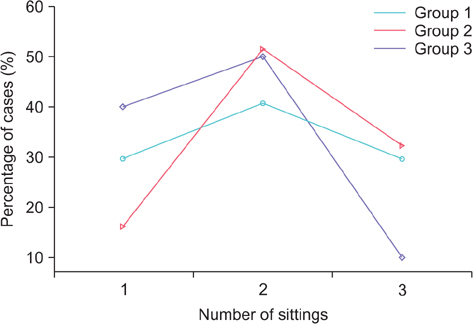Investig Clin Urol.
2017 Mar;58(2):103-108. 10.4111/icu.2017.58.2.103.
Can a brief period of double J stenting improve the outcome of extracorporeal shock wave lithotripsy for renal calculi sized 1 to 2 cm?
- Affiliations
-
- 1Department of Urology, SMS Medical College and Hospital, Jaipur, India.
- 2Department of Urology, R G Kar Medical College and Hospital, Kolkata, India. jn_rpn@yahoo.co.in
- KMID: 2368475
- DOI: http://doi.org/10.4111/icu.2017.58.2.103
Abstract
- PURPOSE
Extracorporeal shock wave lithotripsy (ESWL) is an established modality for renal calculi. Its role for large stones is being questioned. A novel model of temporary double J (DJ) stenting followed by ESWL was devised and outcomes were assessed.
MATERIALS AND METHODS
The study included 95 patients with renal calculi sized 1 to 2 cm. Patients were randomized into 3 groups. Group 1 received ESWL only, whereas group 2 underwent stenting followed by ESWL. In group 3, a distinct model was applied in which the stent was kept for 1 week and then removed, followed by ESWL. Procedural details, analgesic requirements, and outcome were analyzed.
RESULTS
Eighty-eight patients (male, 47; female, 41) were available for analysis. The patients' mean age was 37.9±10.9 years. Stone profile was similar among groups. Group 3 received fewer shocks (mean, 3,155) than did group 1 (mean, 3,859; p=0.05) or group 2 (mean, 3,872; p=0.04). The fragmentation rate was similar in group 3 (96.7%) and groups 1 (81.5%, p=0.12) and 2 (87.1%, p=0.16). Overall clearance in group 3 was significantly improved (83.3%) compared with that in groups 1 (63.0%, p=0.02) and 2 (64.5%, p=0.02) and was maintained even in lower pole stones. The percentage successful outcome in groups 1, 2, and 3 was 66.7%, 64.5%, and 83.3%, respectively (p=0.21). The analgesic requirement in group 2 was higher than in the other groups (p=0.00). Group 2 patients also had more grade IIIa (2/3) and IIIB (1/2) complications.
CONCLUSIONS
Stenting adversely affects stone clearance and also makes the later course uncomfortable. Our model of brief stenting followed by ESWL provided better clearance, comfort, and a modest improvement in outcome with fewer sittings and steinstrasse in selected patients with large renal calculi.
Keyword
Figure
Reference
-
1. Norlin A, Lindell B, Granberg PO, Lindvall N. Urolithiasis. A study of its frequency. Scand J Urol Nephrol. 1976; 10:150–153.2. Lechevallier E, Traxer O, Saussine C. Management of renal stones. Prog Urol. 2008; 18:959–962.3. Shen P, Jiang M, Yang J, Li X, Li Y, Wei W, et al. Use of ureteral stent in extracorporeal shock wave lithotripsy for upper urinary calculi: a systematic review and meta-analysis. J Urol. 2011; 186:1328–1335.4. Ghoneim IA, El-Ghoneimy MN, El-Naggar AE, Hammoud KM, El-Gammal MY, Morsi AA. Extracorporeal shock wave lithotripsy in impacted upper ureteral stones: a prospective randomized comparison between stented and non-stented techniques. Urology. 2010; 75:45–50.5. Sfoungaristos S, Polimeros N, Kavouras A, Perimenis P. Stenting or not prior to extracorporeal shockwave lithotripsy for ureteral stones? Results of a prospective randomized study. Int Urol Nephrol. 2012; 44:731–737.6. Lingeman JE, Newman D, Mertz JH, Mosbaugh PG, Steele RE, Kahnoski RJ, et al. Extracorporeal shock wave lithotripsy: the Methodist Hospital of Indiana experience. J Urol. 1986; 135:1134–1137.7. Cass AS. Comparison of first generation (Dornier HM3) and second generation (Medstone STS) lithotriptors: treatment results with 13,864 renal and ureteral calculi. J Urol. 1995; 153(3 Pt 1):588–592.8. Bon D, Dore B, Irani J, Marroncle M, Aubert J. Radiographic prognostic criteria for extracorporeal shock-wave lithotripsy: a study of 485 patients. Urology. 1996; 48:556–560.9. Shouman AM, Ziada AM, Ghoneim IA, Morsi HA. Extracorporeal shock wave lithotripsy monotherapy for renal stones >25 mm in children. Urology. 2009; 74:109–111.10. Mobley TB, Myers DA, Jenkins JM, Grine WB, Jordan WR. Effects of stents on lithotripsy of ureteral calculi: treatment results with 18,825 calculi using the Lithostar lithotriptor. J Urol. 1994; 152:53–56.11. Thomas R. Indwelling ureteral stents: impact of material and shape on patient comfort. J Endourol. 1993; 7:137–140.12. Mustafa M, Ali-El-Dein B. Stenting in extracorporeal shockwave lithotripsy; may enhance the passage of the fragments. J Pak Med Assoc. 2009; 59:141–143.13. Pryor JL, Jenkins AD. Use of double-pigtail stents in extracorporeal shock wave lithotripsy. J Urol. 1990; 143:475–478.14. Ouzaid I, Al-qahtani S, Dominique S, Hupertan V, Fernandez P, Hermieu JF, et al. A 970 Hounsfield units (HU) threshold of kidney stone density on non-contrast computed tomography (NCCT) improves patients' selection for extracorporeal shockwave lithotripsy (ESWL): evidence from a prospective study. BJU Int. 2012; 110(11 Pt B):E438–E442.15. Mohayuddin N, Malik HA, Hussain M, Tipu SA, Shehzad A, Hashmi A, et al. The outcome of extracorporeal shockwave lithotripsy for renal pelvic stone with and without JJ stent: a comparative study. J Pak Med Assoc. 2009; 59:143–146.16. El-Assmy A, El-Nahas AR, Sheir KZ. Is pre-shock wave lithotripsy stenting necessary for ureteral stones with moderate or severe hydronephrosis? J Urol. 2006; 176:2059–2062.17. Chandhoke PS, Barqawi AZ, Wernecke C, Chee-Awai RA. A randomized outcomes trial of ureteral stents for extracorporeal shock wave lithotripsy of solitary kidney or proximal ureteral stones. J Urol. 2002; 167:1981–1983.18. Bierkens AF, Hendrikx AJ, Lemmens WA, Debruyne FM. Extracorporeal shock wave lithotripsy for large renal calculi: the role of ureteral stents. A randomized trial. J Urol. 1991; 145:699–702.
- Full Text Links
- Actions
-
Cited
- CITED
-
- Close
- Share
- Similar articles
-
- The effect of double-J stent in extracorporeal shock wave lithotripsy monotherapy of staghorn calculi
- Clinical Experience of Extracorporeal Shock Wave Lithotripsy for Urinary Calculi
- The Efficacy of Ureteral Stents in Shock Wave Lithotripsy of Medium Sized Renal Calculi
- Clinical Experience of Extracorporeal Shock Wave Lithotripsy for Urinary Calculi
- Clinical Experience of Domestic SDS-2 Extracorporeal Shock Wave Lithotriptor (ESWL) for 315 Urinary Calculi



